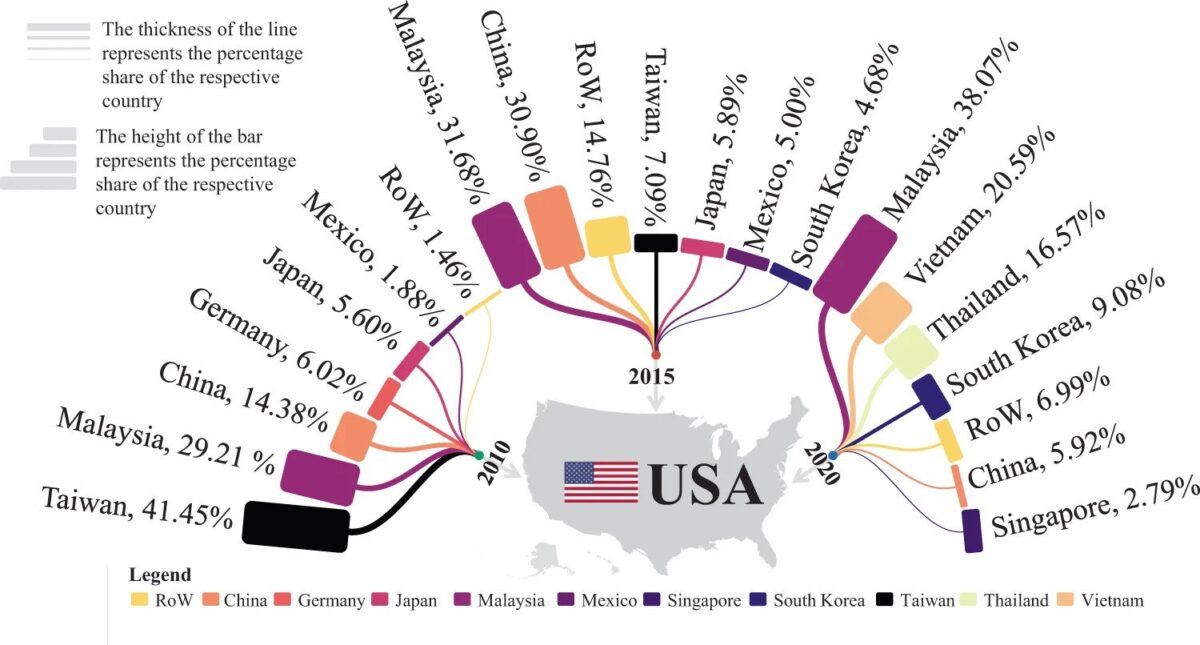From pv magazine global
Domestic production of solar panels could speed up decarbonization in the United States, according to a new study by Cornell University researchers. They shared their findings in “Reshoring silicon photovoltaics manufacturing contributes to decarbonization and climate change mitigation,” which was recently published in Nature Communications.
If solar panel manufacturing returns to the United States by 2035, greenhouse gas (GHG) emissions could be reduced by 30%, said the scientists. Energy consumption could also be cut by 13% from 2020, when the United States relied almost entirely on Malaysia (38%), Vietnam (21%), Thailand (17%), South Korea (9%), China (6%), and Singapore (3%) for PV module imports.
The academics performed a comparative and prospective life-cycle assessment (LCA) to clarify the energy and environmental impacts of bringing crystalline silicon (c-Si) PV production to the United States. The LCA includes emissions during upstream module manufacturing, as well as during operations, maintenance, and end-of-life treatment stages.
They conducted a quantitative analysis based on global warming potential (GWP) and cumulative energy demand (CED), by comparing the offshore manufacturing cases from 2010 to 2020 and the reshored manufacturing scenarios from 2020 to 2050.
“The reshored scenario in 2020 is studied to examine the climate impacts of solely bringing manufacturing back to the US by comparing it with the outsourced manufacturing case in 2020,” the scientists explained. “Moreover, reshored scenarios from 2025 to 2050 in five-year increments are forecasted with cleaner power compositions such as wind, solar, geothermal, etc., building up from 21% renewable power contribution in 2020 to 42% in 2050.”
The results show that domestic manufacturing of c-Si PV modules in the United States in 2020 could have reduced GHG emissions by 23% and energy use by 4%.
“The differences in power mixes between countries lead to discrepancies in climate change impacts of silicon manufacturing, which directly results in the gap in GHG emissions between the [scenarios],” the researchers said.
Looking forward to 2050, the increasing share of solar PV in the U.S. electricity mix is expected to further help reduce GHG emissions in domestic solar panel fabrications by 33%, compared to relying on international supplies in 2020.
“By 2050, around half of U.S. electricity will come from solar energy,” said Fengqi You, one of the paper’s co-authors. “Now, we only have about 3%. The U.S. is ramping up. We are going to increase solar capacity from 74 GW in 2022 to a projected 1,600 GW by 2050. That means we will need a lot more panels in the next three decades.”
This content is protected by copyright and may not be reused. If you want to cooperate with us and would like to reuse some of our content, please contact: editors@pv-magazine.com.








By submitting this form you agree to pv magazine using your data for the purposes of publishing your comment.
Your personal data will only be disclosed or otherwise transmitted to third parties for the purposes of spam filtering or if this is necessary for technical maintenance of the website. Any other transfer to third parties will not take place unless this is justified on the basis of applicable data protection regulations or if pv magazine is legally obliged to do so.
You may revoke this consent at any time with effect for the future, in which case your personal data will be deleted immediately. Otherwise, your data will be deleted if pv magazine has processed your request or the purpose of data storage is fulfilled.
Further information on data privacy can be found in our Data Protection Policy.